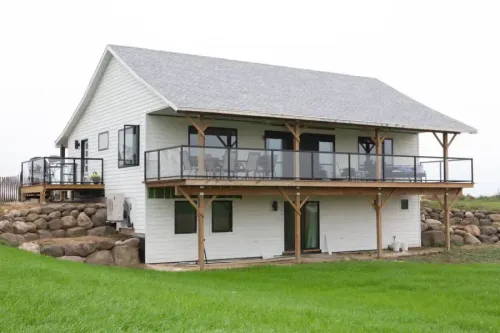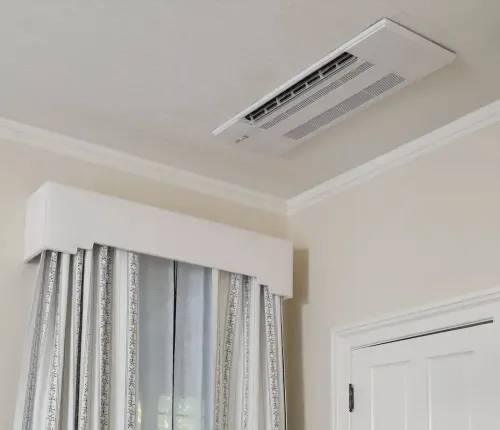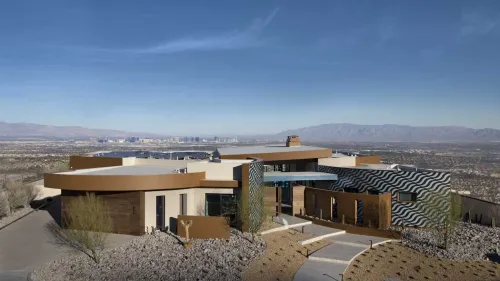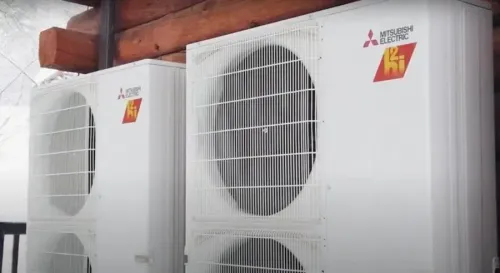Project Location: Salisbury, Massachusetts
Completion Date: November 2014
Challenge
Selecting an HVAC system for an affordable, energy-efficient modular homeSolution
Ductless from Mitsubishi ElectricResult
A green home with low utility bills and ample comfort
Natalie and Tom Treat wanted an eco-friendly and sustainable home – “something as net-zero as possible,” Tom said. When they couldn’t find such a house in their price range, and their exploration into retrofitting a house to be green came up empty, the couple decided to buy land and build an affordable, energy-efficient modular BrightBuilt home in Salisbury, Massachusetts. For cooling and heating, the couple selected a ductless system from Mitsubishi Electric. The result is what Natalie called a “modern, low-impact home that we feel very lucky to live in.”
The Treats were originally drawn to modular homes for their contemporary style and cost-effectiveness. They also knew that modular homes could be customized to fit their green vision, including the installation of solar panels, super insulation, Led lighting, Energy Star® appliances, nontoxic insulation and reclaimed wood flooring. “It was also important to us to have no fossil fuels on-site,” said Natalie.
She continued, “We didn’t want oil or propane in the house for reasons of being green and safe.” For a cooling and heating system, that meant the couple looked at electric options, which would work in conjunction with the house’s rooftop solar panel array to operate at net-zero energy. “I was pretty set on [electric] heat pumps from the start. I know all about heat pump performance because of my job with Northeast Energy Efficiency Partnerships. My organization does a lot of work on market strategies to advance energy efficiency. So I was aware of the value of heat pumps, and of Mitsubishi Electric specifically.”
“I had heard about electric heat pumps, too,” said Tom, “and I wanted to see what people had to say about them. But I also wanted to look at ground-source heat pumps.” As the couple investigated their options, cost savings became a focal point of the discussion. “We knew builders use them for cost savings and energy efficiency. Part of our goal was to do a green home, but the other part was to do it affordably. We realized that electric heat pumps would get us a lot of efficiency at less cost than ground source,” Tom added.
Natalie knew from the start what brand she wanted: “I’ve long known that Mitsubishi Electric is an industry leader. They have a high-quality product. They’ve also been involved in moving the bar forward in terms of market research. So they’re a leader in a lot of ways.”
The Treats opted for a Hyper-Heating INVERTER® (H2i®) system for its strong operation during the northeast’s cold winters. Tim Morris, owner of Morris Heating & Air Conditioning – a Mitsubishi Electric Diamond Contractor® based in Ipswich, Massachusetts – has been working with the Treats since start up. He wholeheartedly agreed with their decision to install an H2 system: “The Hyper-Heating INVERTER systems are super-efficient and quiet. Even at 5 degrees [Fahrenheit], they produce a tremendous amount of heat.”
With the HVAC system selected and other design elements in place, the 2,400-square-foot house was built at the Keiser Homes factory in Oxford, Maine. Natalie said, “The house arrived in four boxes on flatbed trucks. It was done all the way to the plaster on the walls. The electric was in and the plumbing was roughed in.” While assembling the home, the team oriented the house for maximum solar gain and installed the ductless system. “Ductless is always an easier installation than conventional systems – less stressful on our backs, and faster and less disruptive for the homeowner. With lower labor costs for contractors, these savings are passed on to customers,” said Morris.
Natalie said, “The whole Mitsubishi Electric experience has been wonderful. It’s really comfortable, and there are no swings in temperature. I really like that there’s no very hot or cold air blasting on you. It’s gentle, quiet and comfortable.” From Morris’ perspective, the H2i system’s zoning capabilities contribute greatly to comfort: “Everybody’s comfort level is different. You can have a big guy in a sunny room who needs cooling and then a grandma in the corner who weighs 100 lbs. and is freezing at 75 degrees [Fahrenheit]. With ductless, you can accommodate both needs. So people choose these systems, like Natalie and Tom did, for comfort. Also for efficiency and reliability. Simple annual maintenance is all that’s required and these H2i systems will just keep running without the potential issues we sometimes see in traditional ducted systems. Our customers love them. In fact, I have one in my house!”
For Tom, another part of the enjoyment is the system’s unobtrusiveness: “I love the quiet. I don’t hear a furnace kicking on or baseboards clanking, and no oil deliveries!”
Reliable comfort has been especially important to the Treats since February, when they welcomed their first child. In a Massachusetts winter, February can be brutally cold. Natalie said, “Having a baby necessitated putting the set point a little higher. It’s nice to be in a warm house.” Tom has enjoyed using RedLINKTM, their wireless gateway, to make such adjustments right from his smartphone. “I can turn the system on when I’m on the way home. In the winter, when we were on the way home from Vermont, I’d say, ‘Oh, let’s warm up the house so it’s not freezing when we get there!’”
Thanks to the efficient equipment along with plenty of insulation, a higher wintertime set point hasn’t meant a high energy bill, though. Natalie said, “We had a utility bill of something like $300. We were asking our neighbor about it and he said, ‘Are you kidding me? Our bill was $1,300.’ So we’re doing pretty well from a cost perspective.” Tom said he had a similar conversation with a relative “who has a standard house. Even though our house is totally electric and we plug in an electric car, our bill was a lot less, and our place is much bigger than theirs.”
Electric Powerwise circuit monitoring has allowed the Treats to gather even more specific data on the electricity consumption behind their bills. The learned, for example, that their two condensers use, on average, 11.8 and 12.1 kWh a day. Over the course of a year, the two condensers together will consume approximately 8,724 kWh – less than half of the 19,431 kWh Bay Staters use on average each year, per the U.S. Energy Information Administration’s most recent energy survey.
Natalie and Tom are not the only people who have taken notice of their home’s extraordinary story and performance. Boston Magazine approached the Treats about selecting their house as the 2014 Design Home, which meant staging it and opening it for tours to benefit the Boston Children’s Hospital. In deciding to accept the honor, Natalie said, “As part of Design Home, we knew that more than a thousand people would be touring through our house. That was good. If we were going to build a super green home like this, we wanted people to see it and know it could be done. We wanted them to visit and say, ‘Oh look, there’s a beautifully styled bedroom with a heat pump.’”
Project Team
- Owners: Natalie and Tom Treat
- Builder: Ridgeview Construction, Deerfield, New Hampshire
- Modular Design: BrightBuillt Home, Portland, Maine
- Design Coordinator: Lisa Wasserman Sivan Architectural and Interior Design, Brookline, Massachusetts
- HVAC Contractor: Morris Heating & Air Conditioning, Ipswich, Massachusetts
Equipment Installed
- (1) MXZ Outdoor Unit
- (1) MUZ Outdoor Unit
- (4) MSZ Wall-mounted Indoor Units









